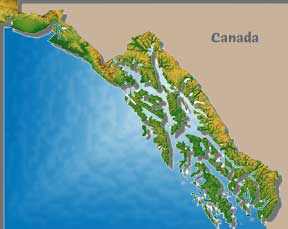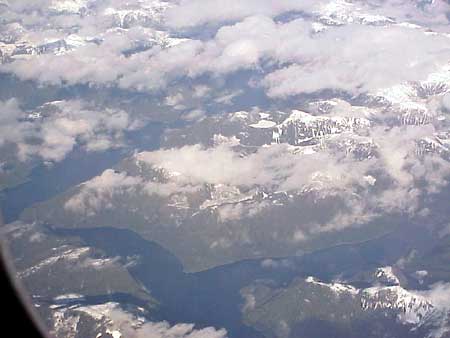Southeast Alaska, Juneau and the Inland Passage
Juneau, Alaska's capital, is a city with multiple personalities
and, as might be expected in such a city, just a touch of paranoia.
Visitors encounter quite different communities, depending on
the time of year when they arrive.
It is a tourist city in the summer, with many visitors arriving
by cruise ship. The cruise ships dominate the harbor and their
passengers fill the streets of the small downtown area looking
for souvenirs and absorbing the local color. Some take helicopter
rides to the nearby Mendenhall Glacier; some ride the tram up
the side of one of the mountains overlooking the city.
From January to mid-May, Juneau is a political city. Legislators,
their staff members, lobbyists and concerned citizens from around
the state gather for the annual session, filling hotels and
other lodging places. Some even stay in boats in the harbor.
The fall and early winter are Juneau's quiet season, when its
30,000 residents venture out. They include the employees of
state government offices and students and faculty members of
the University of Alaska Southeast, which is the smallest of
the University of Alaska's three branches.
The touch of paranoia can be blamed on the occasional efforts
of legislators from other parts of the state to move the capital
to a more central location as well as to the fact that part
of the city lies within an avalanche zone.
 Juneau's
weather ranges from pleasant to frequently rainy to very dramatic.
A joke about Juneau is that houses are never painted because
it's either raining, about to rain or has just rained. The rainiest
season is in late fall. Taku winds that have been recorded at
well over 100 miles an hour can provide the most dramatic weather. Juneau's
weather ranges from pleasant to frequently rainy to very dramatic.
A joke about Juneau is that houses are never painted because
it's either raining, about to rain or has just rained. The rainiest
season is in late fall. Taku winds that have been recorded at
well over 100 miles an hour can provide the most dramatic weather.
Southeast Alaska is largely a collection of islands and archipelagos.
Cruise ships wend their way among them to some of the state's
oldest communities including Sitka, founded in 1804 and the
capital of Russian America before becoming the territorial capital
of Alaska in 1906. Several communities, including Juneau, Skagway
and Haines, owe their existence to early gold strikes and to
the Klondike Gold Rush. Haines and Skagway are the only communities
in Southeast Alaska that are accessible by road, though there
has been talk over the years of linking Juneau, too, to the
Canadian road system.
|

 Juneau's
weather ranges from pleasant to frequently rainy to very dramatic.
A joke about Juneau is that houses are never painted because
it's either raining, about to rain or has just rained. The rainiest
season is in late fall. Taku winds that have been recorded at
well over 100 miles an hour can provide the most dramatic weather.
Juneau's
weather ranges from pleasant to frequently rainy to very dramatic.
A joke about Juneau is that houses are never painted because
it's either raining, about to rain or has just rained. The rainiest
season is in late fall. Taku winds that have been recorded at
well over 100 miles an hour can provide the most dramatic weather.